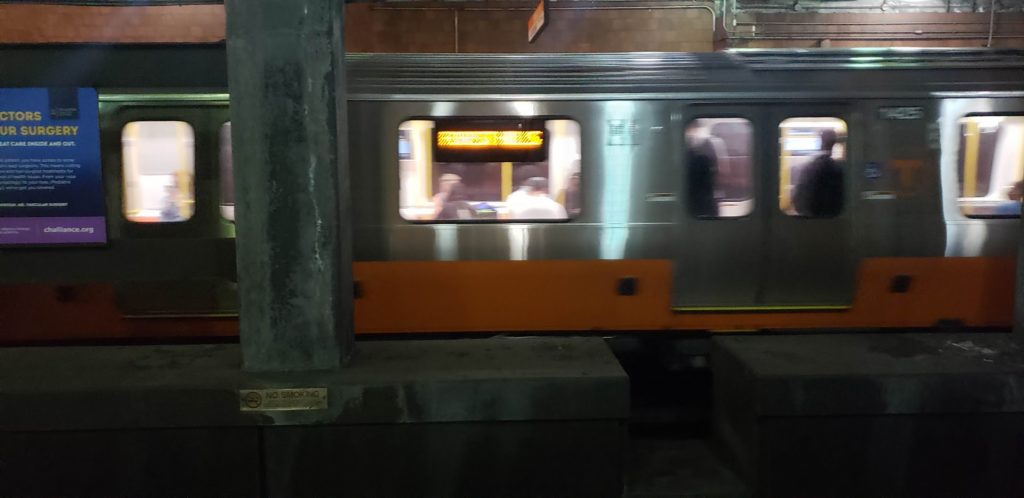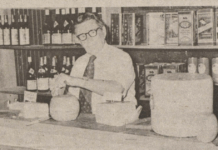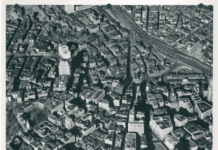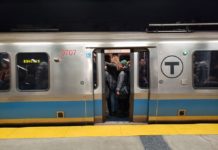by MIKE FREEDBERG
SPECIAL TO EASTBOSTON.COM
This season of our lives we’re watching the MBTA break down in diverse ways at diverse places. It frustrates us, as well it must. Detours abound. Alternative commuting options get sought.
For many of us, working from home rescues us from hours wasted. But what of those who cannot work from home? Will we ever know an MBTA that works like a clock, that arrives on time and departs on time? Or, that does not derail or encounter signaling failure?
Experience suggests to me that such a wish will remain mostly a wish. The T may work, and it may not work. It’s built into what we have. Let’s take a deeper look:
Seven years ago, when Governor Baker took office, an enormous snowstorm stopped the T cold (literally), forcing him to confront transit failure at the point of service. What he decided, and presented, was something much more ambitious: he would, in addition to rescuing the T from the immediate cold, entirely reconfigure the T’s management, its financial arrangements, and its planning. The legislature gave him everything he requested, and he did, in fact, successfully redeploy the T’s operations.

That was actually the easy part.
Baker also had to face the T’s huge backlog of deferred maintenance, some of it unattended for 40 years. The system’s trackage had to be replaced. Almost every line’s signaling system was in disrepair. Transfer boxes and switches needed immediate replacement. The Orange and Red Line’s new trains, ordered during the Patrick administration, would not arrive until 2020, if not later. As it turned out, the firms contracted to build them had in some cases to be cut loose, their contracts reassigned elsewhere. Even then, the new trains arrived with a bag full of snags. They still suffer of these. As for signaling and track electrics, their troubles have never ended. It is unlikely they ever will.
Baker was told, and announced, that the Federal agency charged with monitoring public transit system safety accounted deferred maintenance needing immediate upgrade would cost over $8 billion just to bring their condition back to “state of good repair.” Actual improvement, much less replacement, would cost much, much more. But the Commonwealth did not have such sums and could not easily acquire them. Baker said so. Nonetheless, the legislature enacted two large bond bills earmarked for “state of good repair” standards. We use those borrowed funds even now.
Baker burned through two General Mangers before giving the job to Steve Poftak, a Roslindale resident. In my opinion, Poftak has done everything one could ask of a T manager. He has taken up priority repairs and, working only at night and on weekends, completed most jobs ahead of schedule and below budget. Yet this season’s many breakdowns prove the limits even of top-flight, diligence.
As for costs, as I write this, the T has announced it must upgrade the Red Line’s two and a half miles of the High Speed, Mattapan Line at a cost of $ 123.7 million. You read that right.

It is time now for me to widen the scope of this report. Please bear with me:
The T wasn’t built from scratch. It has used adaptation to get to where it now is. When the private, railroad corporations that provided transportation services to greater Boston went bankrupt during the Depression (and before it), the Commonwealth picked up most of the operating costs in order to keep the trains running. Those trains (and trolleys) ran on rights of way acquired during the 1800s. Those same rights of way continue today, as do the mostly concrete, stone, or crushed stone rail beds and passageways on which the T’s lines rails sit. These basic structures, including the road bridges that pass overhead, have ben, or still are, in ever worsening disrepair. The recently enacted federal infrastructure bill will almost, certainly allocate massive monies for upkeep of these basics; yet most of these repairs will: (1), be done in piecemeal because you can’t just shut down an entire T line and, (2), they will be “state of good repair” only, not reconstruction.
Yet in most cases it’s reconstruction that’s needed. Think of the complete relocation of the Green Line at Lechmere, in which the entire structure approaching the old Lechmere has been demolished and the line re-erected about 100 feet to the north, with entirely new tracks, roadbed, structure, signaling, and station.
This complete rebuild cannot be applied to the rest of the T. First, its cost would – as the High Speed Line’s $ 123.7 million makes clear — be enormous. Second, the T could never acquire the rights of way it would need. What was doable in the 1800s isn’t doable today. The T is stuck with the rights of way that it has. Which also means that it cannot shut down a line and then spend several years – as it took to rebuild and extend the Lechmere section of the Green Line – with said line out of service. Nor is shuttle busing a general option. First, it increases the burden on highway traffic, and second, it requires hiring a private bus line, at serious extra taxpayer expense, as has now been done with Yankee Bus to provide service for the present Blue Line and Orange Line disruptions.
It’s not just the T itself. As we have now seen, damage to structures at the street level, under which the subway T operates, puts the T’s subway tunnels at risk. Not to mention that those subway tunnels were first built 120 years ago and continue to rely upon structures put in place long, long ago. For example, tunnels on the Green Line between Boylston and Arlington still have rail lines in them long disused as well as tunnels in which they run. Most haven’t been repaired in at least 80 years. From Boylston south runs a now unused subway tunnel that once opened onto Tremont Street near where I 90’s underpass now lies.
This is not a new situation. Infrastructure has its own staying power that commits a society to assist its staying. A history of Rome in the Dark Ages and Middle Years – the lives of the Popes thus instruct us — is basically one long record of fixing the city’s aqueducts, of keeping them from leaking. Whatever else the damaged city did or was unable to do, it kept the aqueducts working. At vast cost. Sound familiar?
The proposed Blue Line-Red Line connection, from Bowdoin to Charles Station, will use a tunnel that hasn’t been used in decades. Doubtless this short stretch of tunnel will be extensively rehabbed if the connection actually gets funded. But the tunnel is cut through bedrock, and I don’t see any rehabilitation bolstering the bedrock cuts. The same is true of the Boston Harbor Blue Line tunnel, first built in 1904 and much today the same as it was then, albeit widened in the 1940s.
Portions of the Harbor tunnel that do not lie deep under the Harbor’s bedrock run less deep under massive skyscrapers and dozens of other buildings all of which have foundations bored into the ground. How safe from structural risk thereby are these portions of the Harbor tunnel? I can’t begin to compute the cost (to the taxpayer, of course) that structural renovation of these tunnels would cost.
Yet every bit of work done on T infrastructure costs tons of money. The labor is all highly skilled, mostly union work. The equipment is very specialized. Architects, environmentalists, DEQE experts, aquifer experts, landscapers, are all needed along with a passel of community outreach people (just ask the managers of the Green Line extension). Years and years of effort are required – by which time the repairs or upgrades originally planned may well have become out of date. If you have any doubt, just look at the Catch-22s and decades that have elongated the proposed South Coast commuter rail buildout.
Frankly, I’d put the South Coast Rail phantasm out of its misery. Will we?
But hey — keep the aqueducts working!
Mayor Wu, and other city politicians, want to make the T free of charge, adding even more to the taxpayer burdens of keeping the system from complete collapse; and these elected officials — and several “transportation advocates” — want to add billions of taxpayer dollars to create a high-speed rail line to Springfield — a line that will cost a fortune if it even gets built, which doubt, and which almost no one will use. There’s a reason why passenger rail has all but disappeared from America except in the northeast corridor.
When all is said, the vast majority of us travel not by publicly-funded transportation systems but by personal vehicles — either cars, trucks, motorcycles or bicycles. We do this because the freedom to move where we want to, when we want to, is way, way more important to us than to wait for a T train or bus that may not come, out in whatever weather, and to ride among a crowd of people, many with backpacks shoved in our faces, and whatever sort of persons may occasionally disrupt the peace. Who needs any of this? We use the T only when we absolutely have no other choice.
In addition, it costs far less per mile to repair highways and bridges than to do the same to the T or even the easier to operate commuter rail, and road repair can be done by shutting down half the lanes on a road. You can’t do that on the T. Repairing it means shutting it down.

Frankly, the T as a rescue system only — an accommodation to those who cannot go without it — is how it should be. The T is, as it was when first assumed by the State, for people who cannot drive or who cannot afford to buy a car and put it on the road, or who prefer not to use a bicycle (which has its own set of inconveniences). We as a society agree to pick up most of the cost of such transporting because no one should be barred from moving about (despite the burdens of public transit) because of limited means or disability.
Let’s keep the T and commuter rail running, yes. But why must anyone who isn’t dependent on it be asked to depend on it? Expand it beyond its immediate environs? We’ve done that with the extended Green Line because an existing rail right of way was available to use and upgrade. I’m bearish about any other such ventures.
For 30 years planners have talked about extending the Blue Line to Lynn. It hasn’t happened. The original objection was that an extended Blue Line would bring poor people into the North Shore. This nasty argument scared off the planners. Which is a shame: 30 years ago, the Blue Line could have been extended at a mere fraction of what it would cost now. Today, the bigot rationale has left us, thank goodness, but the present difficulties with T structure and operation makes everyone wary of Blue Line expansion.
Should this dream and potential other rapid transit dreams come true in our lifetime? Environmentalists hope so. Personally, I think we as a society have enough to do just keeping the MBTA we have from going the way of Rome’s unrepaired aqueducts.
— July 7, 2022
Mike Freedberg is editor and publisher of the blog, Here and Sphere. He is also a political consultant. He regularly contributes original, participatory content to EastBoston.com.














